Text
when was TETRIS originally created?

The answer to this question you'll find is the year 1984 or more specifically June 6, 1984. It's widely known that's when the first version of Tetris was created, but is that date accurate?

As of 2022, sites such as Wikipedia and even the official Tetris website cite that Tetris was created in 1984 which when you dig into the sources for that date, it's actually incorrect and the story behind Tetris being created in 1984 is bizarre.
Before we can get into that though, we need to ask when Tetris was actually created. Unfortunately while we don't have an exact date, sources from before 2009 cite that Tetris was created in 1985.

Not only that, but the copyright for Tetris has its creation date listed as 1985, and you can actually see this copyright year in modern versions of Tetris such as Tetris Effect: Connected.

So with prior sources and even the copyright lining up with the year 1985, what resulted in the year getting "corrected" to 1984? Well a post on the Tetrisconcept forum by user necrosaro did some digging into this all the way back in 2014 and concluded that the June 6, 1984 date came about from a marketing campaign to "celebrate Tetris's 25th anniversary" in order to raise awareness of the Tetris brand.
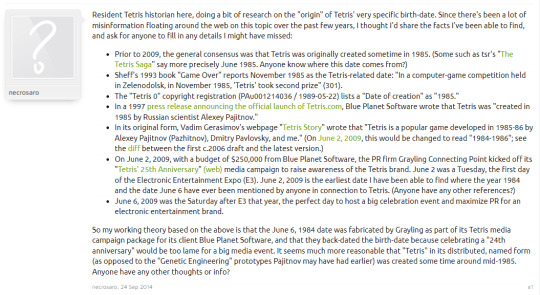
User cgwg also points out that the public dumps of the original computer version of Tetris have build dates ranging from April 1985 to April 1986.

Now you could argue that 1984 is in-fact the actual date and the 1985 date from sources before 2009 were wrong. Well that doesn't hold much water as an email was sent to Vadim Gerasimov (one of the original co-developers of Tetris) asking about the discrepancy.
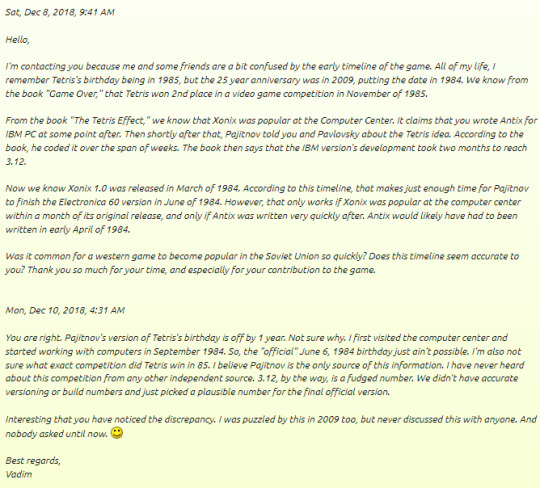
That pretty much explains itself, he didn't even start working with computers until September 1984 yet the reported creation date for Tetris is June 1984. Coupled with the dates on the public dumps of the original game and it's clear that Tetris was created in 1985.

To this very day, June 6th 1984 is still widely reported as when Tetris came out, but I strongly advise you look into those sources and ask where that date came from cause the truth is, it was merely fabricated for an event back in 2009.
14 notes
·
View notes
Text
The source of the video game bleeps and bloops in media

Have you ever wondered what the source of those specific video game bleeps and bloops were from? Odds are if a show or movie had a character play a video game or if a scene takes place in an arcade than it's very likely that it uses the same distinct sound effects that originally were sourced from the Atari VCS (2600) ports of Donkey Kong and Pac-Man. These ports are already historically important with Donkey Kong being one of the few Nintendo games to be released on non-Nintendo hardware and Pac-Man being one of the most anticipated releases for Atari at the time. Today these ports are often mocked for how butchered they are to the arcade originals but at the time these were fine ways to experience these arcade games at home.

So why are the sounds from these arcade ports used so often in media? You can pretty much thank the widespread use of a particular sound effect library and in this case the Series 1000 Sound Effects Library which initially released on tape in 1979 and released on CD in 1983. A good chunk of this library contains the same sounds found on another sound library called the Network Sound Effects Library.

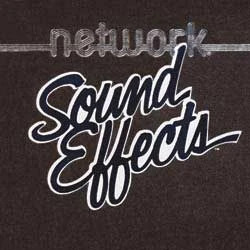
The Series 1000 library however includes audio recordings of gameplay from these Atari games. Ever since then, these sounds have been used for many years and continues to be used to this very day. Before I showcase some examples of media using these sounds I would like to present the recordings from these games. The following is sourced from the Series 1000 Sound Effects Library which feature sound effects from Atari arcade ports.
If you're familiar with these ports than you can make out the specific sound effects present from these recordings. The distinct walking and jumping sounds in Donkey Kong and the dots being eaten and game over sounds from Pac-Man are the more identifiable sounds you hear. With this in mind here are a handful of examples of these sounds being used in media.
(Note: Due to Tumblr restricting one video per post I have compiled all the example clips in a single video so feel free to read below for the specific sound bytes used whilst the video plays.)
Arthur (1996)
The season 1 episode "Arthur Accused!" has Buster investigating an arcade which features sounds from Pac-Man as it eats ghosts and a faint sound of Pac-Man dying from a ghost.
Drake & Josh (2004)
The season 2 episode "The Bet" has Josh playing your typical video game but features several seconds of audio from Donkey Kong. Weirdly music from the Nintendo NES version of Tetris (Type-A specifically) can be heard when Josh is playing on his "handheld" which is clearly a red Game Boy Advance SP.
SpongeBob SquarePants (2007)
The season 5 episode "Atlantis SquarePantis" features a segment of Sandy in a retro inspired environment. The puzzle game segment features various cut up sound bytes from Donkey Kong including jumping over barrels and the walking sounds.
Chowder (2008)
The season 1 episode "Sniffleball" features a brief sound effect from Donkey Kong of Mario jumping over a barrel. (also what is this retro nonsense?)
Ted (2024)
The season 1 episode "Just Say Yes" features Ted and John playing Super Mario Bros. on the NES. For whatever reason no footage of the game is shown and the audio used is from, you guessed it those Atari games. Donkey Kong sound effects can be heard while brief snippets of Pac-Man can also be heard mixed in.
I could keep going but you get the idea. There are plenty of other examples you can find and I highly recommend checking out the Sound Effects Wiki if you're curious to see what other examples are out there. Linked below are the articles for the other sources for these Atari recordings.
Sound Ideas, ARCADE, VIDEO GAME - VIDEO GAME: ELECTRONIC SOUNDS, AMUSEMENT PARK, FAIR 01
Sound Ideas, ARCADE, VIDEO GAME - VIDEO GAME: ELECTRONIC SOUNDS, AMUSEMENT PARK, FAIR 02
I guarantee most folks nowadays aren't even aware that these sounds are from actual Atari games cause out of context they sound like generic bleeps and bloops. That's probably why it's so common to hear these sounds in media as unless you're a nerd like myself this is something you're likely not going to think about and I'd imagine the folks working with audio aren't gonna stop and think about where particular sounds come from outside of the library they're featured in.
77 notes
·
View notes
Text
Reproductions are just Counterfeits with a different name
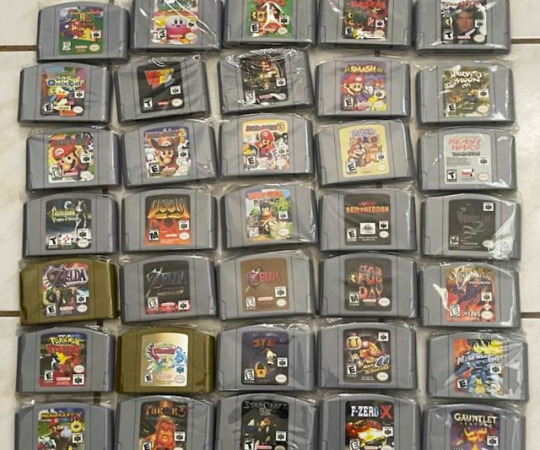
Since the dawn of time, video games have been copied illegally and sold on the second hand market without the endorsement of license holders. However it was pretty easy to tell the difference between a legit copy of a game and a bootleg. You couldn't fool anyone that this was a legit copy of Super Mario Bros. 3, right?
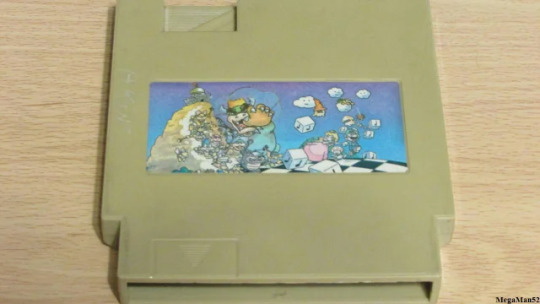
They were often sold for cheap, or in some cases were able to be rented. However as console gaming moved from cartridges to discs these bootleg cartridges slowly started to fade away in western markets. They didn't completely disappear but the prominence of them dwindled up until the 2000s. Then slowly but surely, we started to see cartridges pop up that look like the real deal but are actually counterfeit.
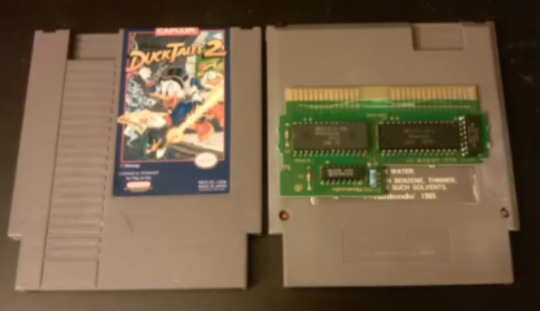
These are often called "Reproductions" or "Repros" for short. Despite the new name, the purpose of these cartridges still serve the exact same purpose as those bootleg cartridges from decades ago. Except this time these repros were made to look real to the point where it can fool people who don't know any better. Sure the hardcore collector can easily tell which is real or counterfeit, but everyone else?
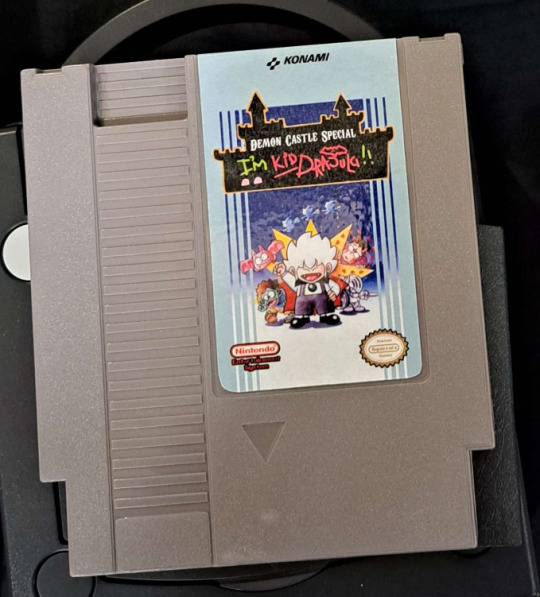
But wait! There are also cases of "reproductions" being made of games that technically don't exist. Here we have a copy of Kid Dracula on NES which... hang on a minute! This was a Famicom game that never left Japan which never saw an NES release. This also seems to contain an English fan translation which I doubt the manufacturer of this cartridge got permission to use that for this cartridge. So wait why even call this a reproduction to begin with? This isn't mimicking anything that exists, it's no different to any other counterfeit cartridge.

There's also folks who consider modern cartridges such as this to be "reproductions". This is not trying to replicate anything that exists. It's a bootleg multicart, it's also not a "fake" game. The games on this cartridge are very real but the cartridge itself is worth next to nothing due to it being counterfeit.

There's also a huge issue with "reproductions" being sold for an absurd markup. Even if its not trying to replicate an existing game, why would you spend around $40 for what is essentially an unlicensed cartridge that realistically is worth dirt. If your argument is because this allows you to play these games on original hardware then invest in a flash cartridge or anything that lets you run rom files on original hardware which negates ever considering purchasing any of this.
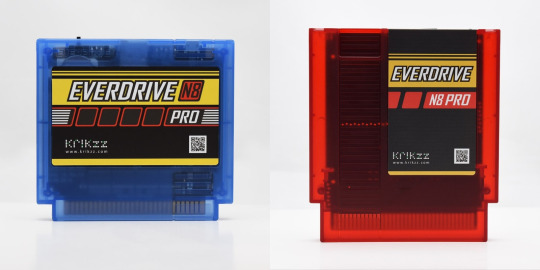
I'm not a huge fan of calling all these newly manufactured cartridges reproductions when there are many which clearly do not fall under the actual definition of a reproduction. For something to be labeled as a reproduction it must replicate the original such as this EarthBound cartridge.

It's clearly based on the real thing and without further inspection looks close enough to the authentic cartridge. Compare that to other cartridges such as this seemingly innocent North American cartridge of Animal Crossing. The thing is that this never left Japan at least on the N64. So would you call this a reproduction?
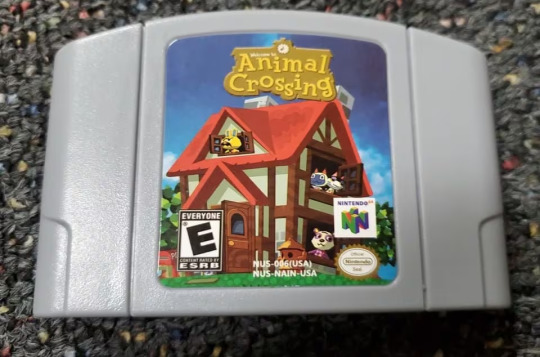
Going by the actual definition it does not qualify due to it not replicating the original cartridge but instead mocking up what an American copy would look like. Since its distinct from the original cartridge I find it hard to call it a reproduction when it isn't even reproducing anything outside of the core game within (with a stolen fan translation might I add). If you were to give it a label it's simply a counterfeit or unlicensed cartridge despite the fake ESRB and Nintendo seal on the cartridge.

If I had to guess as to the reason why everything of this nature is labeled as reproductions is probably just to cover up the fact that these are by nature unauthorized copies of games which in return technically falls under copyright infringement. So its likely that this term is widespread to cover up that fact. That's not to say I'm completely against cartridges like this in general. I like collecting the odd bootleg cartridge every so often, but these newer cartridges don't appeal to me. I'll just stick to either buying original copies or play these games on flash cartridges.
6 notes
·
View notes
Text
Predictions for Nintendo Switch Online
I think it goes without saying that the Nintendo Switch Online (or NSO) service has been controversial to say the least. The fact that we now have to pay for what used to be free online and the lack of benefits you get to subscribing has led to this service being received very poorly at least at launch. It's been about 5 years since NSO launched and a lot of that controversy has seemingly dried up either by new additions to the game library or simply the fact that we're just used to it at this point.

Now don't get me wrong there are still detractors to NSO, but it seems as if this service has been accepted for what it is despite its flaws, although I do have to agree with some of the things said by folks regarding how the service launched and how it currently is.
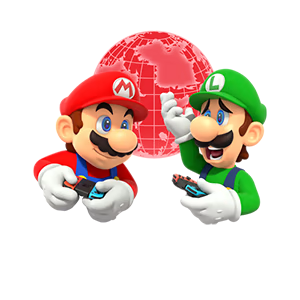
Now that we've gotten that out of the way, I want to lay down some predictions regarding the future of this service as I've seen some wild things being proposed by fans that sound completely unrealistic and nothing Nintendo would ever regularly do. Starting with the obvious, what future platforms will Nintendo add to the game library?
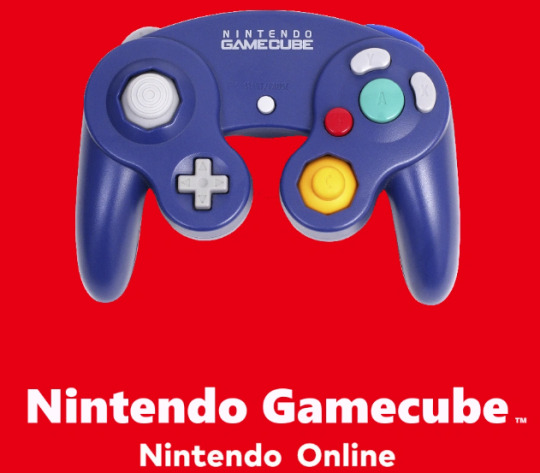
First things first, GameCube is not going to happen at least for a long time. I suspect Nintendo may add it once the Switch's successor is out but at this very moment it is laughable to consider GameCube right now. The biggest main issue is the fact that Nintendo themselves has been rereleasing GameCube games as full price Switch games. Metroid Prime Remastered and Paper Mario: The Thousand Year Door come to mind. I know for the most part the whole "things releasing outside of NSO means it will never come to NSO" myth has more or less died at this point but GameCube tends to be a special case here since these games still feel modern enough to resell as new games.
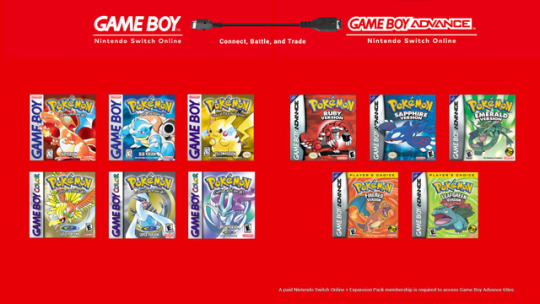
Another thing is to completely throw out any consideration of any mainline Pokémon games appearing on the Game Boy apps. The spinoffs sure, but actual mainline games is a bit silly. If they were somehow to be added they would need to do a lot of backend stuff to get these games properly working and so players don't cheat with the regular tools NSO offers such as rewind and restore points. It's not impossible but I see this as too much work to be worth it if simply putting these out as digital eShop releases sounds much easier. Besides if every version was put out on NSO then you'd lose the magic of Pokémon just like that, and that wouldn't be fun would it?
Okay so what do I actually think NSO is gonna add to its game library? Well unless Nintendo puts out a Virtual Boy or a Game & Watch app then I suspect we will probably see more third party apps. One consideration I don't see a ton of people talking about is the PC-Engine and TurboGrafx-16.
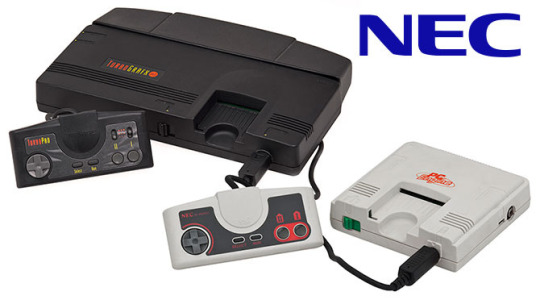
Games from these consoles have appeared on Virtual Console in the past on Wii and Wii U and a very limited number of PC-Engine games did release on 3DS only in Japan. I wouldn't doubt that Nintendo would add this as apart of their Expansion Pack, heck maybe even regular NSO if we're lucky. I would just love to see more NEC love (or well Konami love now).

But why stop there when the Mark III and Master System could be added too? Sega is already on board with NSO with their Mega Drive and Genesis apps so this would be a great addition especially since these games have not been given enough love even by Sega. SG-1000 would also be cool but that might be a bit too niche for a service like NSO but who knows.
As for games, while there is quite a bit already on the service there are certainly omissions that are quite baffling so let's get some of the more obvious ones out of the way and in no particular order.
Gomoku Narabe Renju, Mahjong, Golf, Urban Champion, SimCity, Mario Paint, Super Smash Bros., Ridge Racer 64, Banjo-Tooie, Super Mario Land, Qix, X, Balloon Kid, Mole Mania, Super Mario Bros. Deluxe, Pokémon Pinball, Densetsu no Stafy 1-3, Mother 3, and Rhythm Tengoku just to name a few.
So lets start with one that might not be interesting at a glance but would be a great addition to the service.

Tetris for the NES (no, not the Tengen version) is one of the more iconic versions of this beloved puzzle game, but why go back to this version specifically? I mean we already have Tetris on the Game Boy app and plenty of other Tetris games on Switch so what's the deal here?
Well for one, this version has never seen any kind of rerelease... kind of. This version in terms of how it played was ported over to Tetris Effect: Connected as a side mode but unless you knew about it I'd imagine not a whole lot of folks have dabbled with it and it's still technically not the original game.

But secondly, the main reason why this mode even exists and also why I personally would like to see it on NSO is purely to make the game accessible to a wider audience considering the competitive scene of this specific classic version of Tetris.

Being able to play this on NSO would mean a ton more people get to experience how this version plays and more importantly gives players another option of playing this without resorting to unofficial PC emulation. Obviously pro players are going to stick to original hardware but if you just wanted to practice or wanted a taste of this version then it's no wonder that having it on Switch would be a dream. Hopefully with the Game Boy version already being on the service this will increase the chances of this one happening.
So this next one is already planned to release for NSO in Japan but there's no word on it releasing internationally but regardless...

...Kaeru no tame ni Kane wa Naru or as its unofficially known as The Frog For Whom the Bell Tolls. It's an action RPG that's often compared to Link's Awakening to the point where in said Zelda game there's a cameo appearance featuring Prince Richard from Bell Tolls. This is one of the more well known Nintendo developed games that never left Japan and as of writing has never seen an official English localization of any kind and unfortunately there seems to be a trend with international NSO releases having Japanese games that have not been translated. So the likelihood of this not only releasing outside of Japan but getting a new localization for NSO is very unlikely but it's more than possible given Nintendo puts in the work to translating this in English. I'd imagine a remake of this game being far more likely to getting an international release if that were to happen and hey if it's in the style of the Link's Awakening remake that would be pretty cool.
So let's move away to one that might actually happen.
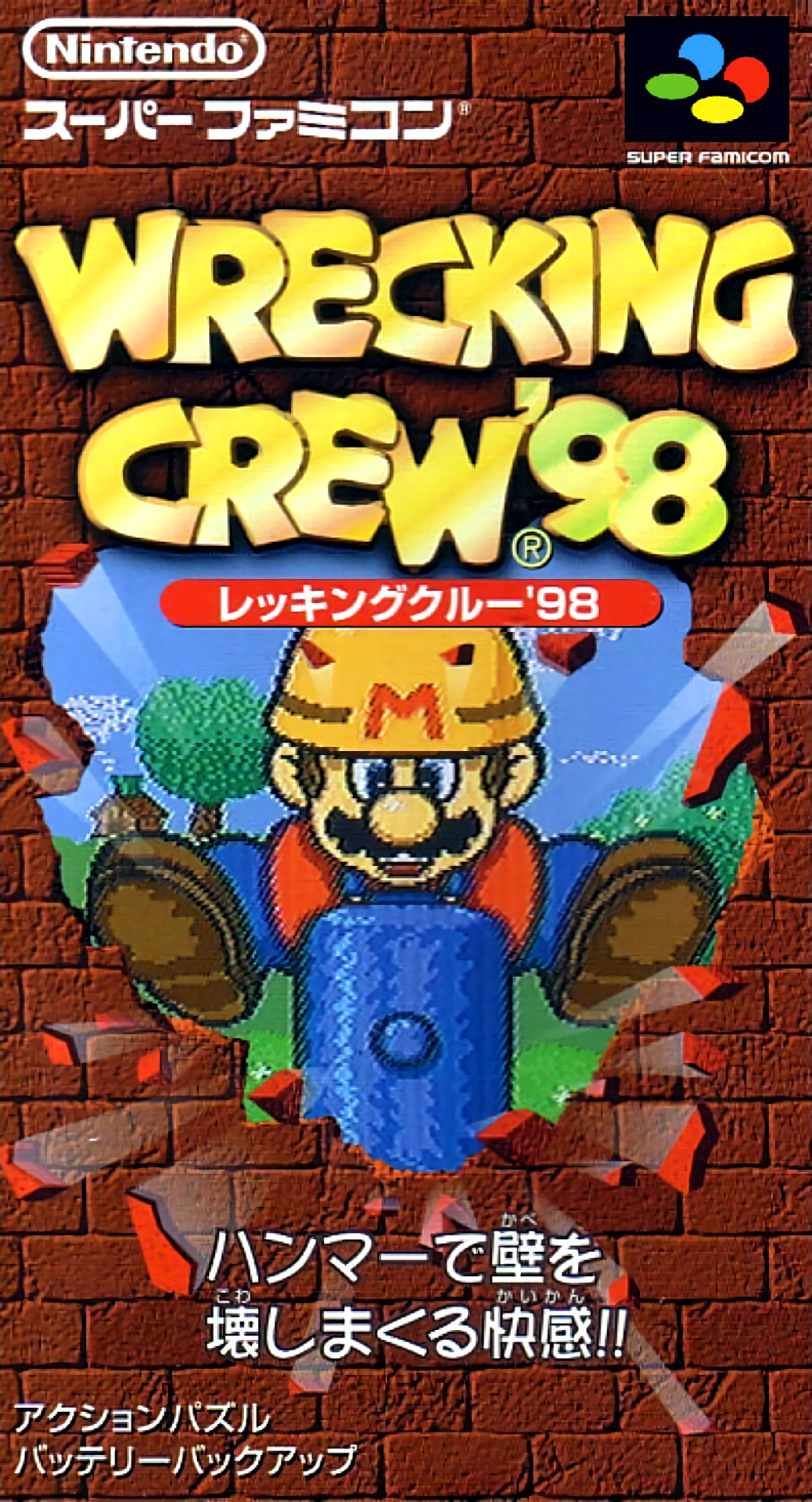
This one's pretty straight forward and don't be scared by this being Japan exclusive as outside of some story cutscenes this one's perfectly playable as its mainly a puzzle game. It has seen rereleases in the past on Virtual Console and if it were to release on NSO it's very likely that it would release internationally since the benefit of Nintendo not putting in effort to localize these games means they can just drop this on the SNES app no problem. Also good time to mention that this also includes the original Wrecking Crew so it would be funny to see Wrecking Crew on the service twice.
So let's end this game prediction saga with one that probably will never happen but if it were to happen I'd be curious how it would be implemented.

So let's get this out of the way, this is an M rated game. For a while it was believed that Nintendo would shy away from more mature games from appearing on the service but GoldenEye 007 on N64 at least in Japan indicates that Nintendo's solution is purely to bump up the rating of the overall app. So I'd imagine if this were to drop on NSO we'd not only see a rating bump for the N64 app but hopefully some kind of parental control option to stop players under 17 from playing this one. While it would be cool to see this on NSO in terms of being able to play it on a Nintendo platform again, I purely would like to see this get added just to see what they'd do to the app in response to this M rated addition to the service.
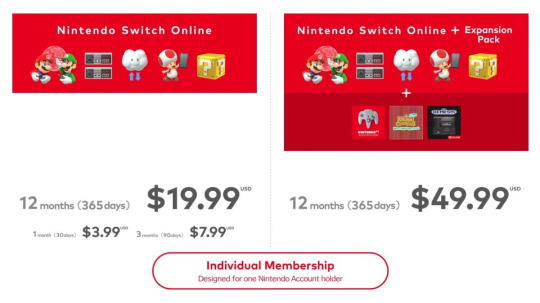
And there are my NSO predictions as of November 2023. I do wonder when the next Nintendo platform releases if we'll see an uptick in support for the service but its likely that this slow trickle of games will continue as usual. I'd normally would wish for more platforms to be represented on NSO but the problem is that some of the ones already on the service are very lacking especially Game Boy and Game Boy Advance. Hopefully those libraries get beefed up soon.
9 notes
·
View notes
Text
You should check out Famidaily - 1041 episodes of every Nintendo Famicom cartridge release

Today marks the end of the longest running chronological YouTube series on a video game library with over 1000 releases. RndStranger has been uploading daily episodes of each Famicom release with new episodes dropping daily hence the name Famidaily (Famicom daily).

The series covers the often overlooked history and library of the Family Computer or Famicom for short. Documentation in regards to these 8-bit games on the English side of the internet tends to be in favor of the context of the NES rather than the Famicom. This has resulted in a very western biased history in regards to Nintendo's 8-bit console history and in many ways Famidaily illustrates just how different the game industry was in Japan compared to America and Europe. Not only that but a lot of Famicom releases which never saw the light of day outside of Japan are practically unknown to the rest of the world.
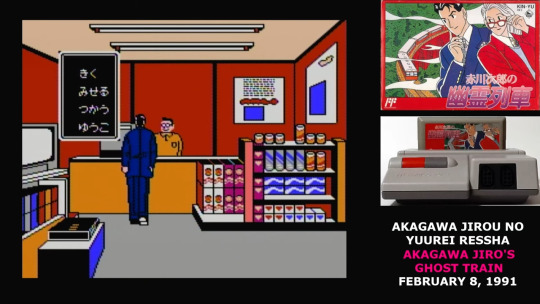
Each episode of Famidaily is 5 minutes on average with shorter episodes being less than 3 minutes and longer episodes being around 8 minutes or more. He then describes the content of the game, how its played, and most importantly the historical aspect and reception of the particular game in Japan. There is a surprisingly amount of influential releases, truly great games, and downright awful train wrecks that are covered in Famidaily that you almost never hear anyone else talk about which makes this such a fascinating series to watch. Considering the reputation of the NES in English speaking circles it's actually insane how little the Famicom gets brought up considering the influences those original releases left that did make their way outside of Japan.
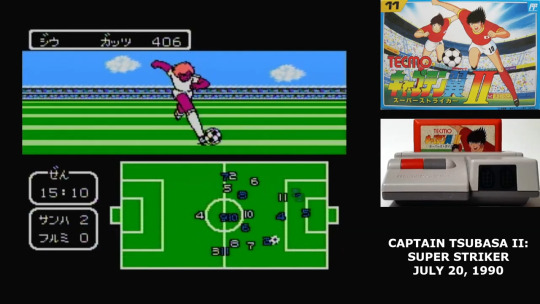
These videos are not only fun to watch but they are an extremely useful resource when it comes to not only researching these games but also understanding the library and particular releases which makes playing and collecting them much more fun and interesting. If you popped in a lot of these releases with no context I'd imagine you would have trouble figuring out how to play and even if that isn't an issue just being able to get the proper context is truly refreshing.

Easily one of my favorite episodes hands down goes to Splatterhouse: Wanpaku Graffiti. Outside of Japan this game is well known as a hidden gem that was exclusive to the Famicom. But this episode highlights a story that I am shocked nobody else has ever brought up considering how historically important it is when it comes to the relationship with Namco and Nintendo at the time. It's notably Namco's final Famicom release for a good while after their original licensing contract expired with this game releasing just one day before said contract was set to expire. Understanding this also helps to explain why all of Namco's previous 1989 releases turned out the way they did. You truly learn something new when watching this series.
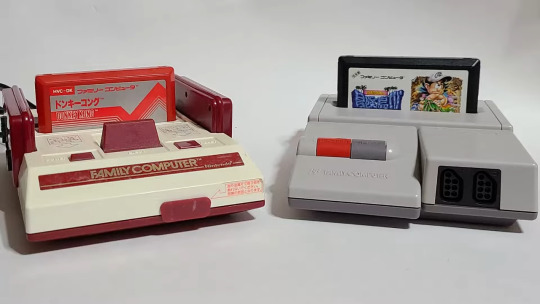
That leaves us to today on November 7, 2023 where the final episode of Famidaily was released covering the final Famicom cartridge release Takahashi Meijin no Bouken Jima IV, better known as Adventure Island IV outside of Japan.
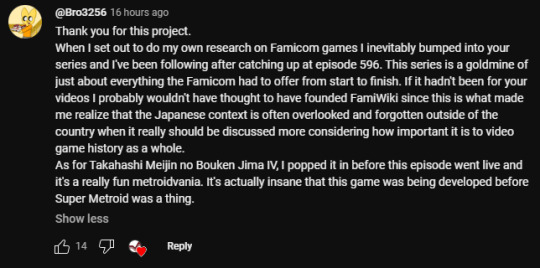
I cannot recommend this series enough, it's absolutely worth your time even if you aren't interested in playing a lot of these games. RndStranger does plan on continuing to upload daily videos for the rest of the year and in 2024 he has plans to cover the Famicom Disk System with the series Year of FDS.
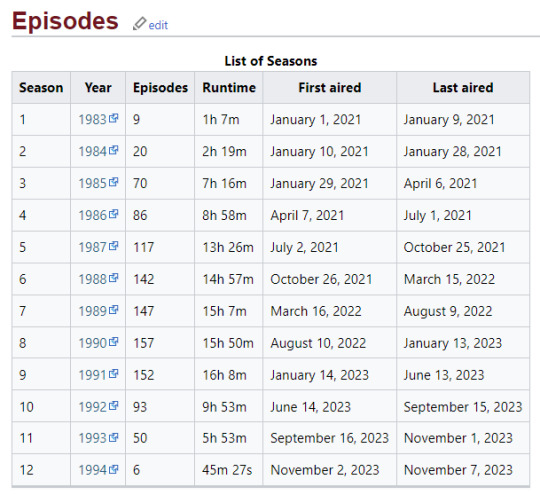
To wrap this up, I might as well mention the total runtime of Famidaily. On average it will take you 116 hours to be caught up with the final episode and that is not counting the dozens of bonus episodes that have also been released alongside the regular daily videos. So go out there and learn something new about Nintendo's original 8-bit cartridge machine and its library. You won't regret it.
19 notes
·
View notes
Text
Some thoughts about Nintendo Switch Online retro games since last time
This is essentially going to be not much of a post but I guess I could talk about a few things about its future since with all the updates that we got since last time.
We'll talk about UI code, Pokémon, NES, Fire Emblem and N64.
UI code upgrade
Literally the next day since my last post about it, on March 16th, Nintendo added new NES, SNES and GB titles. Under the hood, they did do a massive change to the user interface programming, bringing pretty much every NSO app to the latest user interface codebase that GB and GBA NSO had.
That said it brings absolutely no visible changes, NERD has just made sure to bring everything up-to-date. This is just more stable and probably easier to program and manage UI code.
Pokémon Stadium 1 & 2
On April 12th, Nintendo released Pokémon Stadium to NSO + Expansion Pack, and with no Transfer Pak support.
Of course, what did I even expect since there's no old mainline Pokémon titles yet (if ever?).
My opinion about Pokémon on NSO is that it will get stuck to only spinoffs. My worst case realistic scenario (aside from no rerelease) is Pokémon Company selling the old gens at $15 piecemeal (yes, $5 more than on 3DS Virtual Console).
Personally I expect Pokémon Company to be very strict about Pokémon management, and those games are highly abusable with glitches, honestly and are kind of region locked, too to some extent especially between japanese and international players, but they still bothered to rerelease them and supporting them with a way to transfer your Pokémons out of the games.
It's also abusable if you supported the Transfer Pak in Pokémon Stadium titles since they also work like extra boxes for your Pokémons and those support save states, which was explicitly removed out of the 3DS Virtual Console release...
They did also release Pokémon Stadium 2 this week, also without Transfer Pak support.
I did look at the emulator really quick and did find that they added new functions for Lua script hacking for the games, and it does kinda look like they rebuilt the entire thing from a new version at least.
I'll speak more about N64 emulation later.
Mystery Tower
Fast forwarding a bit, on June 6th, Nintendo added more NES, SNES and GB titles. One of them was Mystery Tower by Namco.
This bothered me, because I knew what this game was, but the title did absolutely not sound right. Turns out this title is actually brand new, they had this title in their collection, the original title was "BABEL" which is interesting since this means it is a first case of title change hacks on NSO. That said I did eventually find out that Japan also had a title change to "The Tower of Babel", which was also done in collections, but also the Wii U Virtual Console release!
Anyway please try this puzzle game, just keep in mind the direction and how you can turn around stuff based on how you face it.



Fire Emblem
On June 23rd, Nintendo released Fire Emblem for the GBA NSO app. But Japan also had Fire Emblem: The Binding Blade, the actual first GBA Fire Emblem title, as we only started to get these games since the second GBA title.
I'll refer to them as FE6 (The Binding Blade) and FE7 (Fire Emblem) from now on.
This update was interesting for a couple reasons.
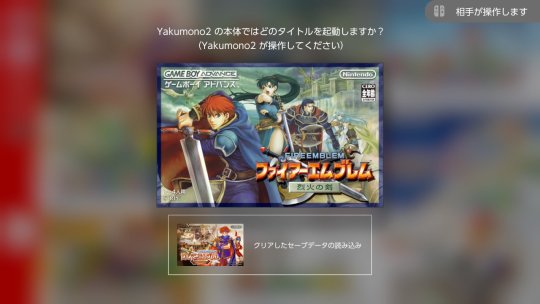
It just so happens that the japanese version of FE7 can link to FE6's completed save files to unlock a couple things in the game.
So now, when you go into multiplayer, after the first player selects FE7, the second player is allowed to select either FE7, or FE6 for "Link Cleared Save Data" (official english text). Another player can simply share their save files to another player.
This also means that the GBA app now has the ability to load different games for each player depending on the choice of the first player who serves as the host.
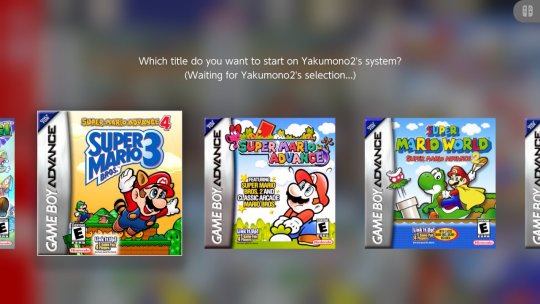
(This screenshot is me messing around with the functionality.)
However this is not the only noteworthy thing to happen, because it wouldn't feel fair for a single player to not being able to transfer their own FE6 saves to FE7. Well, they did actually implement a hack for single player too!
They actually reimplemented the linking process inside the emulator just to avoid emulating a second GBA for it, and it would seamlessly transfer the save data just fine.
If you're wondering about what it unlocks, a quick read made me figure out that it skips Lyn's story, and add new scenes to the epilogue and other small additions as well.
Those new epilogue scenes are available in the US version by default, but not in the EU versions for some reason.
They can also be accessed in the JP version without a save transfer by finishing the game 9 to 11 times (what the heck).
This functionality working as it is really cool, honestly, and it makes a process less painful to do like it was back then, and it did make me feel confident in the transfer of data between games like with Golden Sun & Golden Sun: The Lost Age or the Zelda Oracle games... speaking of...
The Legend of Zelda: Oracle of Ages/Seasons
Those two games ended up randomly coming at the end of July this year. They are known for being two parts of a fuller story if you link each of them from whatever order you start them with.
And that's where my disappointment came in to remind me of the terrible reality that is Nintendo Switch Online.
It is doable for two players to share their save files to each other through multiplayer, but if you wanna do the games yourself on your own in single player, you'll have to input the password you get from the other game.
That is kinda sad considering it's the first player who selects the save file from the other player, it could have been very easy to setup in a way that's easy to use without needing to implement any specific user interface, but that didn't quite happen.
I hope they'll bother for Golden Sun considering the tiers of password this game can have with Golden Sun: The Lost Age, but I am starting to think if the game does offer a way to transfer without needing any additional work, they wouldn't do it. In the case of Fire Emblem, this way of save transfer was the only way to do it.
I did not mention much about this, but Oracle of Ages/Seasons are also known for having exclusive content if you play those games on a Game Boy Advance. After looking into it though, it does not seem like we're missing much, but it's kinda sad that they're not really in their most definitive way to play them.
Pokémon Trading Card Game
Two weeks after those last two games, Pokémon Trading Card Game and Pokémon Stadium 2 were released.
The cool thing about this game, is that they emulated the infrared communications.

At least, Card Pop does work, for sure, which does require emulation of the IR communcation... or does it?
Upon a quick inspection of the emulator code, I found out that the emulator does indeed patch the game ROM's functions, and thanks to the disassembled Pokémon Trading Card Game offering me a lot of information, I found out that they absolutely don't emulate the IR communications at all and outright replace the IR functions to point to a invalid 0xDD opcode (opcodes are small commands that CPU executes)... which probably points to a function in the emulator to specifically manage this.
Ain't that funny? In any case though, they do at least let all IR communications work just fine, and that's what matters.
(For the nerds who wants to look this up, the emulator keeps SHA1 hashes of the ROM you can easily search for, then points to a struct of 100 bytes original to compare, 100 bytes to patch, address, size, and something else I don't get.)
I ended up looking this up as someone pointed me to this video:
youtube
It turns out in the original game, one of the cards, the Phantom Venusaur, is impossible to obtain due to a mistake in the calculations of the odds, on which this video explains very well in detail.
This is the reason that motivated me to look at how the emulator might patch the game, and see if they fixed this issue: They did not fix this problem, I see no patch for any of the relevant code for this.
So, NERD, if you're reading this, look at 06:5D92, you can definitely fix this in one way or another.
N64 emulation
So... the Pokémon Stadium 2 release at least updated the emulator in some way, because they added new functions for the Lua scripting for N64 game hacks, and some of the UI engine stuff got shuffled around.
Then I tried some of the games, to see if some things got fixed:
F-Zero X did NOT get its framerate drop fixed.
Goldeneye's Dam level has texture tiling fixed. Interesting.
Since I noticed this last thing, it was pointed to Graslu00 who knows the game in and out and already compared the emulation of the game on NSO and Xbox... to a disappointing degree.
Here's his thread about the fixes... or rather the lack of:
https://twitter.com/Graslu00/status/1688994099477528576
The update did also some additional fixes to Pokémon Stadium 1, though I don't really know much about it other than it relates to rendering and soft reset in some way.
Unfortunately the N64 emulator is still not up to snuff, but I think the most annoying thing is still the controls. The default controls suck, let us change them in the emulator, per game! Offer also better stick emulation!
It still pains me to rely on the Switch OS remap feature, it's not good for this, it messes too much with some of the macros, it sucks!
It annoys me when I see the text "Change Control Method" in the emulator files too, you guys clearly thought about it! Why isn't it a feature after months with nothing?
Future releases
There's still a couple N64 games left that were explicitly announced for 2023, such as 1080° Snowboarding, Excitebike 64 and Mario Party 3.
That said Japan also had plans for release of Harvest Moon 64 (which I see no reason why we can't get it now that Harvest Moon SNES got released since), but also Goldeneye 007, on which Japan has it on the highest age rating (CERO Z).
Considering how the plans are going and how lazy everything is (sorry devs, I'm sure you guys know already, but most of the results of this just don't impress me and don't fill me with confidence aside from GB/GBA somehow), I just think N64 NSO will randomly get a 18+ rating and put every N64 game under parental control bullshit out of nowhere with no warning for Japan.
Also, where's the alternate languages for NES and SNES games?
20 notes
·
View notes
Text
An interpretation of the Dolphin on Steam situation.
As a reminder, Dolphin, the GameCube and Wii emulator, had announced a release of a Steam version using features from Steam like cloud save, Steam Deck native support and all.
A couple of days ago, Dolphin's Steam page was pulled down, then Dolphin's official blog mentioned a DMCA takedown, and PC Gamer reported on it, quoting the DMCA. Then we all went a bit crazy over this, then Delroth, a former Dolphin member, talked in a bit more detail, and debunked a misunderstanding.
You can still read this from Delroth here: https://mastodon.delroth.net/@delroth/110440301402516214
All in all, the situation was misinterpreted from all sides, and to sum it up, according to Delroth: Valve asked Nintendo about this, and Nintendo said they don't want this, and quoted the DMCA's set of laws. In fact, not only Delroth says this, a lawyer contacted by PC Gamer essentially says the same thing in the updated report here.
One more preface: I am NOT a lawyer, legal text is very hard to fully grasp, this is only my own interpretation of the situation, what I am about to say may be VERY VERY WRONG. Got it?
The Digital Millennium Copyright Act is a copyright law from 1998. It is made of several titles and acts. The first title contains the anti-circumvention part which we'll get to later. The second title contains the takedown process part.
DMCA Takedown
I'll get to the second title first:
To sum it up, this is the part where you can do a copyright infringement claim, a "notice and takedown" process. This process also includes the ability of a counterclaim.
NONE OF THIS HAPPENED ON DOLPHIN ON STEAM. Nintendo did not use this process. They just told Valve a reason, and it was Valve's decision alone that got the emulator removed, and they notified Dolphin of the reason.
I won't really debate much on this, it's not really interesting.
"Anti-circumvention"
Now, the anti-circumvention part, the meaty part. There's a lot of legal text, but I will translate to the best of my abilities to you, don't worry.
This is the part where I feel the least comfortable about, and again, this is an interpretation, but let's start again from that quote that I had (from PC Gamer, by the way):
the Dolphin emulator operates by incorporating these cryptographic keys without Nintendo’s authorization and decrypting the ROMs at or immediately before runtime. Thus, use of the Dolphin emulator unlawfully 'circumvent[s] a technological measure that effectively controls access to a work protected under' the Copyright Act.
The thing is... I only said that indeed, the Wii Common Key, required to decrypt everything, is included in Dolphin's source code. It's... not necessarily the problematic point of this, as I tried to read more into it, and I will go back to the Lockpick_RCM actual DMCA takedown.
Lockpick_RCM is a Switch tool that gets a set of keys from your Switch console and puts them into an easy to read file that could be used in conjunction with other Switch tools. They're required to decrypt pretty much everything about the Switch, from games to other packages.
The use of Lockpick with a modified Nintendo Switch console allows users to bypass Nintendo’s Technological Measures for video games
A thing you read a lot is "Technological Measures"... turns out this has a bit of a definition in 17 U.S.C. §1201... or rather, in that text itself, here's the very first thing you can read:
17 U.S.C. §1201 (a)(1)(A)
No person shall circumvent a technological measure that effectively controls access to a work protected under this title.
The wording "circumvent a technological measure" happens to have a definition tied to it:
17 U.S.C. §1201 (a)(3)
As used in this subsection—
(A) to “circumvent a technological measure” means to descramble a scrambled work, to decrypt an encrypted work, or otherwise to avoid, bypass, remove, deactivate, or impair a technological measure, without the authority of the copyright owner; and (B) a technological measure “effectively controls access to a work” if the measure, in the ordinary course of its operation, requires the application of information, or a process or a treatment, with the authority of the copyright owner, to gain access to the work.
It's a somewhat precise definition, actually, and purely relying on it... this makes pretty much everything Wii, 3DS, Wii U and Switch a very dangerous situation.
The "technological measure" also has a definition:
17 U.S.C. §1201 (a)(3)(B)
a technological measure “effectively controls access to a work” if the measure, in the ordinary course of its operation, requires the application of information, or a process or a treatment, with the authority of the copyright owner, to gain access to the work.
Basically it just means a DRM (Digital Rights Management) process of sorts.
A lot of people loves to talk about the previous lawsuits on emulators, but note that I never mentioned the emulation being the issue here.
Nintendo is NOT arguing, on a legal level anyway, that emulators are illegal by being one, their communication team does by stifling innovation in their public arguments.
According to 17 U.S.C. §1201 (a)(3)(A), just having encryption is enough to consider that they're protected, and just decrypting is already illegal... this affects a lot more than you think, it's not just Dolphin at this point, it seems we misunderstood a lot of things about the DMCA.
To sum it up more bluntly: I don't feel like the encryption key is the main argument, it's actually about what you do with it that they argue against.
So even if Dolphin removed the Wii Common Key, if they still include the decryption process, even if you provided the key yourself from your own system, EVEN your own Wii dumps, the argument here implies that since you're still decrypting the Wii dump data, this last part is argued to be illegal. This ain't right.
Now apply this to everything else, even if you decrypted the game beforehand so that Dolphin doesn't even decrypt anything, the problem would be moved to the dumper or the decrypter tool doing it. This applies to a lot of systems.
Considering the definition I showed earlier, this seems hard to argue against, however, notice that I never said anything as fact, and insisted that it is Nintendo's argument, legally speaking, I believe this is an important distinction to make.
Exceptions?
The law also explicitly defines exceptions to this, but please read carefully, because this is where I start to really interpret from here:
In 17 U.S.C. §1201 (a)(1)(B), my understanding is that when the protection itself prevents legitimate use, then you are allowed to break it. That said, and this is important: The later subparagraphs defines these paragraphs as something that CANNOT BE USED AS A DEFENSE. This is only there to shield the Library of Congress from any attack, and to allow them to research the various impacts that the protection does and determine rules. Their ruling is also explicitly not allowed to be used as a defense in the text.
After reading a lot of this, I only found one thing that, very honestly, I find quite unclear. Subsection (f) about Reverse Engineering, is particularly showing how much they're not well versed in computer science.
17 U.S.C. §1201 (f) basically says if you're trying to understand how the program works, you are allowed to circumvent the protection, under the idea that you're doing analysis, or...
17 U.S.C. §1201 (f)(2)
for the purpose of enabling interoperability of an independently created computer program with other programs, if such means are necessary to achieve such interoperability, to the extent that doing so does not constitute infringement under this title.
In the case of infringement, I believe this is about copyright in general, as the law suggests this does not affect copyright laws in any way.
So what is interoperability... well let's take the definition from there:
17 U.S.C. §1201 (f)(4)
For purposes of this subsection, the term “interoperability” means the ability of computer programs to exchange information, and of such programs mutually to use the information which has been exchanged.
So we're talking about the ability for a program to exchange information with the work, in this case, a game for example.
...what is this? Programs exchange information all the time. That's even the basis of a computer. Maybe there are other definitions, but frankly I can't be bothered to read even more legalese right now.
With just this, and not taking into account anything else, I feel like this allows emulators to work, they don't really modify the game, they try to run it within a sandbox, where a lot of information is exchanged to make sure the program runs as intended.
Oddly enough this would still make the ability to run those games on a modded Switch still illegal though, while emulators could be allowed to do this.
But make no mistake: This is not a legally tested argument. I need to repeat: This is an interpretation.
Lawsuits literally work with lawyers interpreting information and the laws, and argue. The whole idea of laws being unclear is not necessarily a fault, it's specifically why lawyers exist.
Why now? And what now?
Honestly, as much as Nintendo argued, for the time being, they have not shown any intention to take down Dolphin as a whole.
They could just argue as a scare tactic to prevent Dolphin to reach an even more mainstream status. I doubt Nintendo didn't know about Dolphin for that long.
Until I see an actual DMCA takedown, or worse against Dolphin itself, I'm going to assume Dolphin will stay up for a long time.
Removing the Wii Common Key from Dolphin will not change the situation, as it is the whole decryption process that the argument is about.
Whether Citra, Cemu, Yuzu and Ryujinx could have included the keys or not, the argument would still be the same here.
TL;DR of the complicated part
About the takedown itself:
Valve asked Nintendo about Dolphin on Steam, and they argued that Dolphin is illegal because it decrypts Wii games, and Valve, on their own accord, took down Dolphin from Steam from this.
(Note: GameCube does not use encryption and cannot be impacted by this.)
An actual lawyer also takes this as a warning from Nintendo to Valve according to PC Gamer.
About the argument that Nintendo used against Dolphin:
Encryption Keys are NOT the main point of contention, because...
The encryption itself, as a whole, is argued by Nintendo to be a protection measure.
This means that decrypting the game outside of the intended way by the copyright owner (Nintendo, on a Nintendo Switch) is argued to be illegal by default.
The law, as in how I interpret it, goes in that sense, but for some reason you are allowed to make an additional program that can "interoperate" with the protected works in question and explicitly is allowed to break the protection. This is a vague part, and could be used in defense of Dolphin, potentially.
The final answer can only be answered in a courtroom.
53 notes
·
View notes
Text
An interpretation of the Dolphin on Steam situation.
As a reminder, Dolphin, the GameCube and Wii emulator, had announced a release of a Steam version using features from Steam like cloud save, Steam Deck native support and all.
A couple of days ago, Dolphin's Steam page was pulled down, then Dolphin's official blog mentioned a DMCA takedown, and PC Gamer reported on it, quoting the DMCA. Then we all went a bit crazy over this, then Delroth, a former Dolphin member, talked in a bit more detail, and debunked a misunderstanding.
You can still read this from Delroth here: https://mastodon.delroth.net/@delroth/110440301402516214
All in all, the situation was misinterpreted from all sides, and to sum it up, according to Delroth: Valve asked Nintendo about this, and Nintendo said they don't want this, and quoted the DMCA's set of laws. In fact, not only Delroth says this, a lawyer contacted by PC Gamer essentially says the same thing in the updated report here.
One more preface: I am NOT a lawyer, legal text is very hard to fully grasp, this is only my own interpretation of the situation, what I am about to say may be VERY VERY WRONG. Got it?
The Digital Millennium Copyright Act is a copyright law from 1998. It is made of several titles and acts. The first title contains the anti-circumvention part which we'll get to later. The second title contains the takedown process part.
DMCA Takedown
I'll get to the second title first:
To sum it up, this is the part where you can do a copyright infringement claim, a "notice and takedown" process. This process also includes the ability of a counterclaim.
NONE OF THIS HAPPENED ON DOLPHIN ON STEAM. Nintendo did not use this process. They just told Valve a reason, and it was Valve's decision alone that got the emulator removed, and they notified Dolphin of the reason.
I won't really debate much on this, it's not really interesting.
"Anti-circumvention"
Now, the anti-circumvention part, the meaty part. There's a lot of legal text, but I will translate to the best of my abilities to you, don't worry.
This is the part where I feel the least comfortable about, and again, this is an interpretation, but let's start again from that quote that I had (from PC Gamer, by the way):
the Dolphin emulator operates by incorporating these cryptographic keys without Nintendo’s authorization and decrypting the ROMs at or immediately before runtime. Thus, use of the Dolphin emulator unlawfully 'circumvent[s] a technological measure that effectively controls access to a work protected under' the Copyright Act.
The thing is... I only said that indeed, the Wii Common Key, required to decrypt everything, is included in Dolphin's source code. It's... not necessarily the problematic point of this, as I tried to read more into it, and I will go back to the Lockpick_RCM actual DMCA takedown.
Lockpick_RCM is a Switch tool that gets a set of keys from your Switch console and puts them into an easy to read file that could be used in conjunction with other Switch tools. They're required to decrypt pretty much everything about the Switch, from games to other packages.
The use of Lockpick with a modified Nintendo Switch console allows users to bypass Nintendo’s Technological Measures for video games
A thing you read a lot is "Technological Measures"... turns out this has a bit of a definition in 17 U.S.C. §1201... or rather, in that text itself, here's the very first thing you can read:
17 U.S.C. §1201 (a)(1)(A)
No person shall circumvent a technological measure that effectively controls access to a work protected under this title.
The wording "circumvent a technological measure" happens to have a definition tied to it:
17 U.S.C. §1201 (a)(3)
As used in this subsection—
(A) to “circumvent a technological measure” means to descramble a scrambled work, to decrypt an encrypted work, or otherwise to avoid, bypass, remove, deactivate, or impair a technological measure, without the authority of the copyright owner; and (B) a technological measure “effectively controls access to a work” if the measure, in the ordinary course of its operation, requires the application of information, or a process or a treatment, with the authority of the copyright owner, to gain access to the work.
It's a somewhat precise definition, actually, and purely relying on it... this makes pretty much everything Wii, 3DS, Wii U and Switch a very dangerous situation.
The "technological measure" also has a definition:
17 U.S.C. §1201 (a)(3)(B)
a technological measure “effectively controls access to a work” if the measure, in the ordinary course of its operation, requires the application of information, or a process or a treatment, with the authority of the copyright owner, to gain access to the work.
Basically it just means a DRM (Digital Rights Management) process of sorts.
A lot of people loves to talk about the previous lawsuits on emulators, but note that I never mentioned the emulation being the issue here.
Nintendo is NOT arguing, on a legal level anyway, that emulators are illegal by being one, their communication team does by stifling innovation in their public arguments.
According to 17 U.S.C. §1201 (a)(3)(A), just having encryption is enough to consider that they're protected, and just decrypting is already illegal... this affects a lot more than you think, it's not just Dolphin at this point, it seems we misunderstood a lot of things about the DMCA.
To sum it up more bluntly: I don't feel like the encryption key is the main argument, it's actually about what you do with it that they argue against.
So even if Dolphin removed the Wii Common Key, if they still include the decryption process, even if you provided the key yourself from your own system, EVEN your own Wii dumps, the argument here implies that since you're still decrypting the Wii dump data, this last part is argued to be illegal. This ain't right.
Now apply this to everything else, even if you decrypted the game beforehand so that Dolphin doesn't even decrypt anything, the problem would be moved to the dumper or the decrypter tool doing it. This applies to a lot of systems.
Considering the definition I showed earlier, this seems hard to argue against, however, notice that I never said anything as fact, and insisted that it is Nintendo's argument, legally speaking, I believe this is an important distinction to make.
Exceptions?
The law also explicitly defines exceptions to this, but please read carefully, because this is where I start to really interpret from here:
In 17 U.S.C. §1201 (a)(1)(B), my understanding is that when the protection itself prevents legitimate use, then you are allowed to break it. That said, and this is important: The later subparagraphs defines these paragraphs as something that CANNOT BE USED AS A DEFENSE. This is only there to shield the Library of Congress from any attack, and to allow them to research the various impacts that the protection does and determine rules. Their ruling is also explicitly not allowed to be used as a defense in the text.
After reading a lot of this, I only found one thing that, very honestly, I find quite unclear. Subsection (f) about Reverse Engineering, is particularly showing how much they're not well versed in computer science.
17 U.S.C. §1201 (f) basically says if you're trying to understand how the program works, you are allowed to circumvent the protection, under the idea that you're doing analysis, or...
17 U.S.C. §1201 (f)(2)
for the purpose of enabling interoperability of an independently created computer program with other programs, if such means are necessary to achieve such interoperability, to the extent that doing so does not constitute infringement under this title.
In the case of infringement, I believe this is about copyright in general, as the law suggests this does not affect copyright laws in any way.
So what is interoperability... well let's take the definition from there:
17 U.S.C. §1201 (f)(4)
For purposes of this subsection, the term “interoperability” means the ability of computer programs to exchange information, and of such programs mutually to use the information which has been exchanged.
So we're talking about the ability for a program to exchange information with the work, in this case, a game for example.
...what is this? Programs exchange information all the time. That's even the basis of a computer. Maybe there are other definitions, but frankly I can't be bothered to read even more legalese right now.
With just this, and not taking into account anything else, I feel like this allows emulators to work, they don't really modify the game, they try to run it within a sandbox, where a lot of information is exchanged to make sure the program runs as intended.
Oddly enough this would still make the ability to run those games on a modded Switch still illegal though, while emulators could be allowed to do this.
But make no mistake: This is not a legally tested argument. I need to repeat: This is an interpretation.
Lawsuits literally work with lawyers interpreting information and the laws, and argue. The whole idea of laws being unclear is not necessarily a fault, it's specifically why lawyers exist.
Why now? And what now?
Honestly, as much as Nintendo argued, for the time being, they have not shown any intention to take down Dolphin as a whole.
They could just argue as a scare tactic to prevent Dolphin to reach an even more mainstream status. I doubt Nintendo didn't know about Dolphin for that long.
Until I see an actual DMCA takedown, or worse against Dolphin itself, I'm going to assume Dolphin will stay up for a long time.
Removing the Wii Common Key from Dolphin will not change the situation, as it is the whole decryption process that the argument is about.
Whether Citra, Cemu, Yuzu and Ryujinx could have included the keys or not, the argument would still be the same here.
TL;DR of the complicated part
About the takedown itself:
Valve asked Nintendo about Dolphin on Steam, and they argued that Dolphin is illegal because it decrypts Wii games, and Valve, on their own accord, took down Dolphin from Steam from this.
(Note: GameCube does not use encryption and cannot be impacted by this.)
An actual lawyer also takes this as a warning from Nintendo to Valve according to PC Gamer.
About the argument that Nintendo used against Dolphin:
Encryption Keys are NOT the main point of contention, because...
The encryption itself, as a whole, is argued by Nintendo to be a protection measure.
This means that decrypting the game outside of the intended way by the copyright owner (Nintendo, on a Nintendo Switch) is argued to be illegal by default.
The law, as in how I interpret it, goes in that sense, but for some reason you are allowed to make an additional program that can "interoperate" with the protected works in question and explicitly is allowed to break the protection. This is a vague part, and could be used in defense of Dolphin, potentially.
The final answer can only be answered in a courtroom.
53 notes
·
View notes
Text
An interpretation of the Dolphin on Steam situation.
As a reminder, Dolphin, the GameCube and Wii emulator, had announced a release of a Steam version using features from Steam like cloud save, Steam Deck native support and all.
A couple of days ago, Dolphin's Steam page was pulled down, then Dolphin's official blog mentioned a DMCA takedown, and PC Gamer reported on it, quoting the DMCA. Then we all went a bit crazy over this, then Delroth, a former Dolphin member, talked in a bit more detail, and debunked a misunderstanding.
You can still read this from Delroth here: https://mastodon.delroth.net/@delroth/110440301402516214
All in all, the situation was misinterpreted from all sides, and to sum it up, according to Delroth: Valve asked Nintendo about this, and Nintendo said they don't want this, and quoted the DMCA's set of laws. In fact, not only Delroth says this, a lawyer contacted by PC Gamer essentially says the same thing in the updated report here.
One more preface: I am NOT a lawyer, legal text is very hard to fully grasp, this is only my own interpretation of the situation, what I am about to say may be VERY VERY WRONG. Got it?
The Digital Millennium Copyright Act is a copyright law from 1998. It is made of several titles and acts. The first title contains the anti-circumvention part which we'll get to later. The second title contains the takedown process part.
DMCA Takedown
I'll get to the second title first:
To sum it up, this is the part where you can do a copyright infringement claim, a "notice and takedown" process. This process also includes the ability of a counterclaim.
NONE OF THIS HAPPENED ON DOLPHIN ON STEAM. Nintendo did not use this process. They just told Valve a reason, and it was Valve's decision alone that got the emulator removed, and they notified Dolphin of the reason.
I won't really debate much on this, it's not really interesting.
"Anti-circumvention"
Now, the anti-circumvention part, the meaty part. There's a lot of legal text, but I will translate to the best of my abilities to you, don't worry.
This is the part where I feel the least comfortable about, and again, this is an interpretation, but let's start again from that quote that I had (from PC Gamer, by the way):
the Dolphin emulator operates by incorporating these cryptographic keys without Nintendo’s authorization and decrypting the ROMs at or immediately before runtime. Thus, use of the Dolphin emulator unlawfully 'circumvent[s] a technological measure that effectively controls access to a work protected under' the Copyright Act.
The thing is... I only said that indeed, the Wii Common Key, required to decrypt everything, is included in Dolphin's source code. It's... not necessarily the problematic point of this, as I tried to read more into it, and I will go back to the Lockpick_RCM actual DMCA takedown.
Lockpick_RCM is a Switch tool that gets a set of keys from your Switch console and puts them into an easy to read file that could be used in conjunction with other Switch tools. They're required to decrypt pretty much everything about the Switch, from games to other packages.
The use of Lockpick with a modified Nintendo Switch console allows users to bypass Nintendo’s Technological Measures for video games
A thing you read a lot is "Technological Measures"... turns out this has a bit of a definition in 17 U.S.C. §1201... or rather, in that text itself, here's the very first thing you can read:
17 U.S.C. §1201 (a)(1)(A)
No person shall circumvent a technological measure that effectively controls access to a work protected under this title.
The wording "circumvent a technological measure" happens to have a definition tied to it:
17 U.S.C. §1201 (a)(3)
As used in this subsection—
(A) to “circumvent a technological measure” means to descramble a scrambled work, to decrypt an encrypted work, or otherwise to avoid, bypass, remove, deactivate, or impair a technological measure, without the authority of the copyright owner; and (B) a technological measure “effectively controls access to a work” if the measure, in the ordinary course of its operation, requires the application of information, or a process or a treatment, with the authority of the copyright owner, to gain access to the work.
It's a somewhat precise definition, actually, and purely relying on it... this makes pretty much everything Wii, 3DS, Wii U and Switch a very dangerous situation.
The "technological measure" also has a definition:
17 U.S.C. §1201 (a)(3)(B)
a technological measure “effectively controls access to a work” if the measure, in the ordinary course of its operation, requires the application of information, or a process or a treatment, with the authority of the copyright owner, to gain access to the work.
Basically it just means a DRM (Digital Rights Management) process of sorts.
A lot of people loves to talk about the previous lawsuits on emulators, but note that I never mentioned the emulation being the issue here.
Nintendo is NOT arguing, on a legal level anyway, that emulators are illegal by being one, their communication team does by stifling innovation in their public arguments.
According to 17 U.S.C. §1201 (a)(3)(A), just having encryption is enough to consider that they're protected, and just decrypting is already illegal... this affects a lot more than you think, it's not just Dolphin at this point, it seems we misunderstood a lot of things about the DMCA.
To sum it up more bluntly: I don't feel like the encryption key is the main argument, it's actually about what you do with it that they argue against.
So even if Dolphin removed the Wii Common Key, if they still include the decryption process, even if you provided the key yourself from your own system, EVEN your own Wii dumps, the argument here implies that since you're still decrypting the Wii dump data, this last part is argued to be illegal. This ain't right.
Now apply this to everything else, even if you decrypted the game beforehand so that Dolphin doesn't even decrypt anything, the problem would be moved to the dumper or the decrypter tool doing it. This applies to a lot of systems.
Considering the definition I showed earlier, this seems hard to argue against, however, notice that I never said anything as fact, and insisted that it is Nintendo's argument, legally speaking, I believe this is an important distinction to make.
Exceptions?
The law also explicitly defines exceptions to this, but please read carefully, because this is where I start to really interpret from here:
In 17 U.S.C. §1201 (a)(1)(B), my understanding is that when the protection itself prevents legitimate use, then you are allowed to break it. That said, and this is important: The later subparagraphs defines these paragraphs as something that CANNOT BE USED AS A DEFENSE. This is only there to shield the Library of Congress from any attack, and to allow them to research the various impacts that the protection does and determine rules. Their ruling is also explicitly not allowed to be used as a defense in the text.
After reading a lot of this, I only found one thing that, very honestly, I find quite unclear. Subsection (f) about Reverse Engineering, is particularly showing how much they're not well versed in computer science.
17 U.S.C. §1201 (f) basically says if you're trying to understand how the program works, you are allowed to circumvent the protection, under the idea that you're doing analysis, or...
17 U.S.C. §1201 (f)(2)
for the purpose of enabling interoperability of an independently created computer program with other programs, if such means are necessary to achieve such interoperability, to the extent that doing so does not constitute infringement under this title.
In the case of infringement, I believe this is about copyright in general, as the law suggests this does not affect copyright laws in any way.
So what is interoperability... well let's take the definition from there:
17 U.S.C. §1201 (f)(4)
For purposes of this subsection, the term “interoperability” means the ability of computer programs to exchange information, and of such programs mutually to use the information which has been exchanged.
So we're talking about the ability for a program to exchange information with the work, in this case, a game for example.
...what is this? Programs exchange information all the time. That's even the basis of a computer. Maybe there are other definitions, but frankly I can't be bothered to read even more legalese right now.
With just this, and not taking into account anything else, I feel like this allows emulators to work, they don't really modify the game, they try to run it within a sandbox, where a lot of information is exchanged to make sure the program runs as intended.
Oddly enough this would still make the ability to run those games on a modded Switch still illegal though, while emulators could be allowed to do this.
But make no mistake: This is not a legally tested argument. I need to repeat: This is an interpretation.
Lawsuits literally work with lawyers interpreting information and the laws, and argue. The whole idea of laws being unclear is not necessarily a fault, it's specifically why lawyers exist.
Why now? And what now?
Honestly, as much as Nintendo argued, for the time being, they have not shown any intention to take down Dolphin as a whole.
They could just argue as a scare tactic to prevent Dolphin to reach an even more mainstream status. I doubt Nintendo didn't know about Dolphin for that long.
Until I see an actual DMCA takedown, or worse against Dolphin itself, I'm going to assume Dolphin will stay up for a long time.
Removing the Wii Common Key from Dolphin will not change the situation, as it is the whole decryption process that the argument is about.
Whether Citra, Cemu, Yuzu and Ryujinx could have included the keys or not, the argument would still be the same here.
TL;DR of the complicated part
About the takedown itself:
Valve asked Nintendo about Dolphin on Steam, and they argued that Dolphin is illegal because it decrypts Wii games, and Valve, on their own accord, took down Dolphin from Steam from this.
(Note: GameCube does not use encryption and cannot be impacted by this.)
An actual lawyer also takes this as a warning from Nintendo to Valve according to PC Gamer.
About the argument that Nintendo used against Dolphin:
Encryption Keys are NOT the main point of contention, because...
The encryption itself, as a whole, is argued by Nintendo to be a protection measure.
This means that decrypting the game outside of the intended way by the copyright owner (Nintendo, on a Nintendo Switch) is argued to be illegal by default.
The law, as in how I interpret it, goes in that sense, but for some reason you are allowed to make an additional program that can "interoperate" with the protected works in question and explicitly is allowed to break the protection. This is a vague part, and could be used in defense of Dolphin, potentially.
The final answer can only be answered in a courtroom.
53 notes
·
View notes
Text
@bro3256 drew fanart of my Pokesona and like AAAAAAAAAAAAA he's so cute!

Thank you so much!
3 notes
·
View notes
Text
FamiWiki - Addressing the Console Paradox
Recently I opened a new wiki titled FamiWiki with the current focus being the documentation of the Famicom software library, hardware, add-ons, and accessories.

The wiki was created for various reasons but one of the factors that led me into pursuing the creation of FamiWiki was my distaste of Famicom neglect on the English side of the internet. For many years it has collectively been decided by most western users that the Famicom is simply a regional variant of the NES. On paper this is fine, and mind you the lack of documentation of the Famicom is what most likely resulted in the acceptance of this belief. Especially back in the 2000s when hardly anyone outside of Japan knew what a Famicom is. Things have changed a lot within the past 2 decades though and at this point we should really start questioning our prior beliefs we had. Most who are into retro games know what a Famicom is, they probably couldn't tell you anything specific about the Famicom but they'd at least recognize it. FamiWiki aims to have proper documentation of the Famicom but most importantly draw the line between the Famicom and NES.

I made a post several months back about the console paradox. In the post I explained that folks tend to mix the terms console and platform as one thing, when in reality they are distinct terms. On FamiWiki we currently have the following definitions.
Console - A computer designed to play software made for it.
Platform - An ecosystem that encompasses the software designed for specific consoles.
It's more or less the same definitions given within that previous post, but now applied to FamiWiki. The result? We've been able to properly draw the lines between different consoles and platforms while also giving a name for everything in general.

This system we have in place is also very flexible when we need to include other oddities such as actual regional variants and other add-ons. We've been able to create something that's less confusing and makes more sense than what other wikis and websites currently have in place. The acceptance of this however is going to take a while to sink in but I'd imagine when FamiWiki becomes a useful resource for many to reference than that's when things are most likely to change and hopefully inspire the same change elsewhere.
Anyways stop calling the Famicom a Japanese NES when the Famicom actually released officially outside of Japan thus not making it Japanese exclusive.

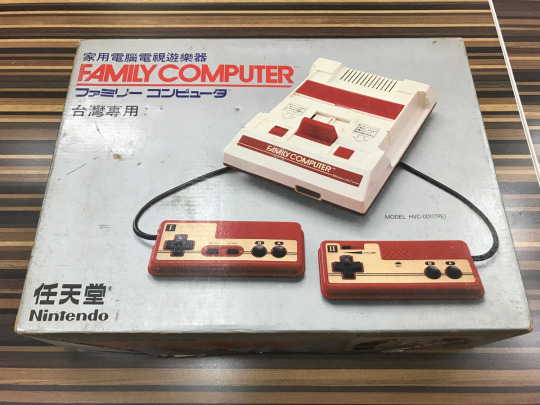
2 notes
·
View notes
Text

Happy birthday @bro3256! In honor of this occasion, here is your OC Roo…well…I'll let the image speak for itself.
9 notes
·
View notes
Text
No, Nintendo DID NOT make an adapter to play Famicom games on the Super Famicom

In 1989, Nintendo unveiled their next home console, the Super Famicom. Their 16-bit successor to their 8-bit Family Computer (or Famicom for short). With a new console came questions regarding its capabilities, one of these questions were if the Super Famicom was backwards compatible with the Famicom.
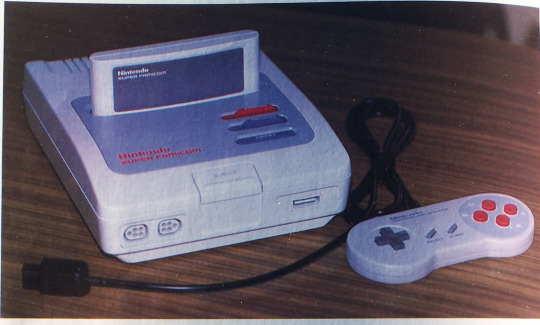
The answer was obviously no, not only were the cartridge slots different but the hardware was incapable of playing 8-bit Famicom games. While it could have been possible to implement, the Super Famicom was an entirely new system that lacked anyway of playing older Famicom games.

So to make up for the lack of backwards compatibility, Nintendo also revealed a new model of the Famicom that not only looked more in-line with the Super Famicom but also allowed the use of Super Famicom controllers. However by all means this new Famicom was its own console completely separate from the Super Famicom. Despite that however many have claimed over the years that this Famicom console is an adapter to play Famicom games on your Super Famicom, even claiming that the Super NES was also planned to have backwards compatibility with the NES.
youtube
Unfortunately this is all bogus. Keep and mind Nintendo clarified that the Super Famicom is incapable of playing Famicom software. This also extends to the Super NES not being able to play NES software. So what's the deal with the way Nintendo presented this new Famicom console?

As mentioned by Chris Covell, the Super Famicom was originally going to passthrough video and power to the new Famicom console which explains the "FAMICOM" switch in-between the power switch and reset button likely to switch between consoles. This also explains why the new Famicom console originally used the same prototype controller ports of the Super Famicom. So while this accomplishes backwards compatibility to an extent, it's definitely not what many had in mind and is no different than having the original Famicom side by side with the Super Famicom. So if this isn't an adapter than what came of this new Famicom console?

In 1993, 3 years after the Super Famicom launched in Japan and 4 years after the Super Famicom was first shown off, Nintendo released the AV Famicom which is likely to be the final version of that new Famicom console we saw earlier. Instead of using Super Famicom ports it uses ports originally found on the NES. The power supply is identical to both the Super Famicom and the original Famicom and the AV Famicom uses Nintendo's muli-out port for video output, the same port found on the Super Famicom.
youtube
So while the AV Famicom is still its own console, you can still theoretically recreate that initial setup Nintendo showcased back in 1989 to not only play Super Famicom games but older Famicom games as well.
TL;DR Nintendo never developed an adapter to play Famicom games on the Super Famicom and any word of an NES adapter on the Super NES by Nintendo is bogus.
6 notes
·
View notes
Photo

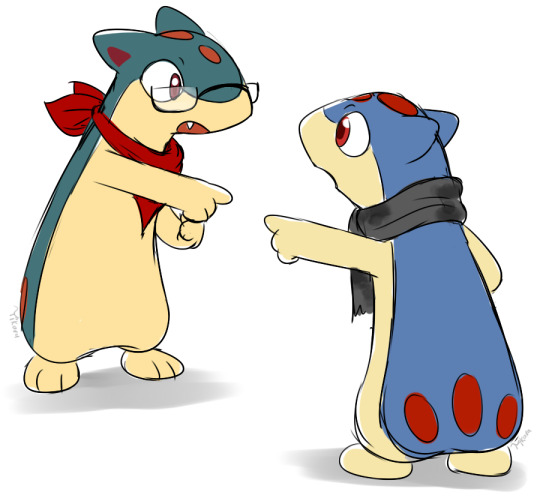



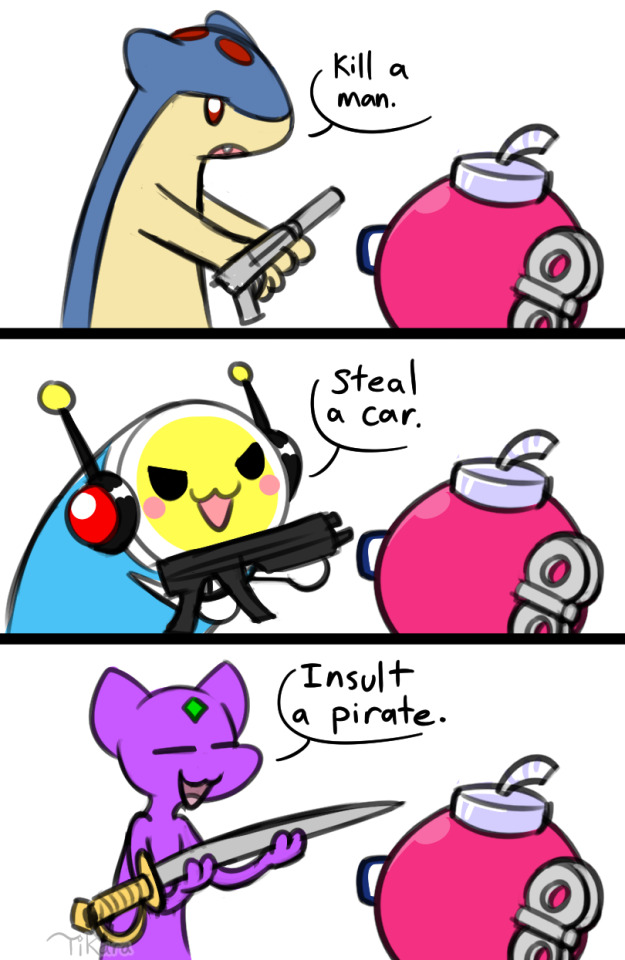
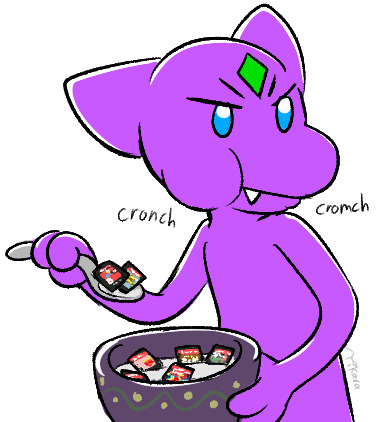
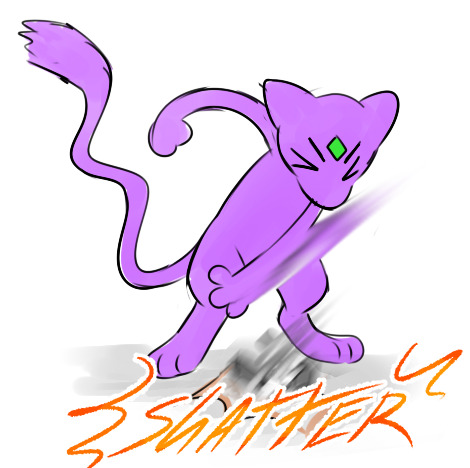

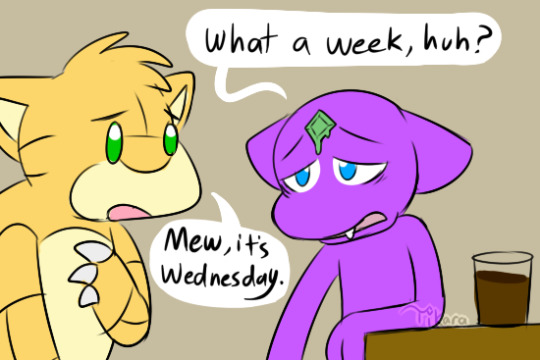
An assortment of drawings involving Tika and friends over the last few years that I’ve yet to archive here! Shenanigans include:
- Species swap with @akfamilyhome + his government mandated Pokésona
- Two Quilavas, RHG1951 and Vice, meet for the first time
- BlizzBlu giving me Steam keys
- Impromptu group movie where a bunch of people watched what is currently the highest rated Sharksploitation movie on IMDb
- @bro3256 learns the hard way that you DON’T mess with the headgem
- Vice, @farey8336, and I become bad influences for AK.
- Tika eating totally normal cereal
- Tika smashing her phone
- Tika, Farey, and @tapswitcher-theoneandonly in a burnout pile
- Me and Wind realizing we’re only in the middle of the week
88 notes
·
View notes
Text
Emulation is not piracy and ROMs are not specifically for emulators
Whenever you see discussion regarding emulation, most of that discussion relates to acquiring ROM files in order to use said emulator. My issue with these discussions is that they tend to mix the concept of emulation and downloading ROMs as one contained thing when that's not the reality of things.

Emulation is a tool to be able to run software that was intended for specific hardware. ROMs in this context are digital copies of existing software. An emulator is simply one of the ways you can use these ROM files, but you can also use these ROMs elsewhere including the original hardware itself.
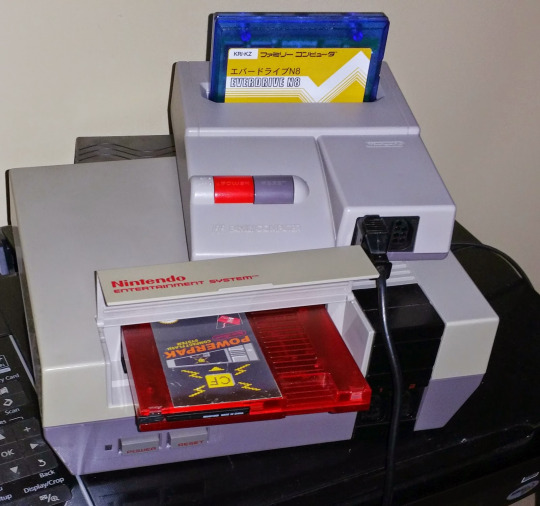
For older cartridge based consoles such as the Famicom and NES, you can use a flash cartridge such as the PowerPak or the Everdrive N8 in order to run these same ROMs like if it were an original cartridge. Loads of different flash cartridges have been made for various other consoles, and there are even similar solutions to disc based consoles such as the Sega Saturn, PlayStation, and Dreamcast.
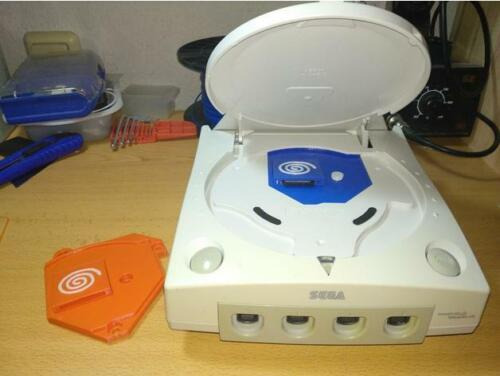
All of these accomplish the same goal of running digital copies of software in place of physical media. These in return are also tools to run these same ROMs. It's even easier for more modern consoles thanks to them having capabilities of storing digital games such as the PSP and Vita but especially the 3DS.
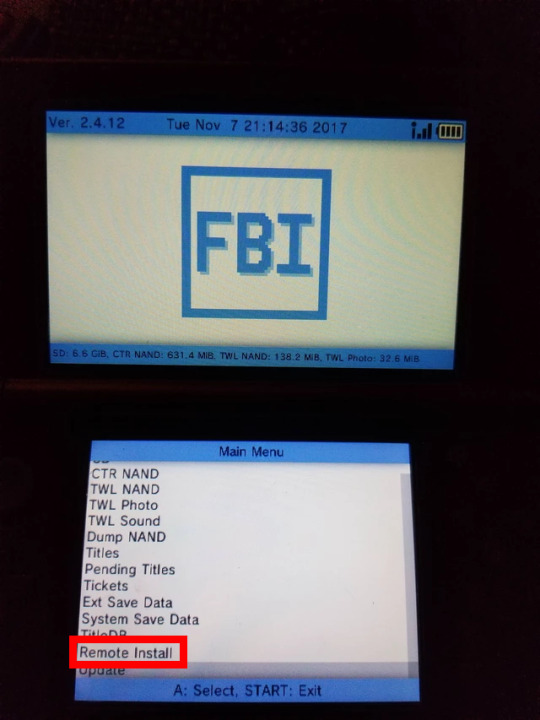
Of course if you don't own any original hardware then using an emulator is definitely the best option. Fact is that if your end goal is being able to play your favorite games, see what options are available to you both officially and unofficially. My rule of thumb is if a game you are trying to play is no longer being sold, then by all means do what you can to acquire a copy even if that means downloading it for free. At that point you must decide whether you still plan on using original hardware or stick with using an emulator.
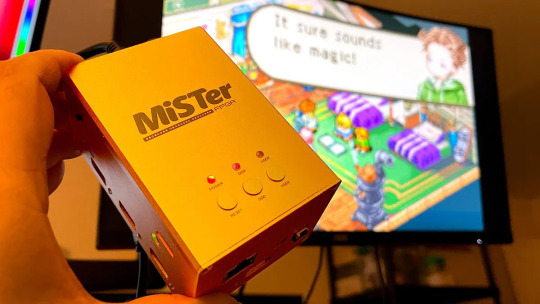
You're picking which tool you want to use in order to play your game, both options accomplish the same goal though so its up to you to decide as to what works for you.
TL;DR: Emulation and ROMs are not the same thing. Emulation is a tool and ROMs exist as a way to use those tools which can also be used with flash cartridges, hardware modifications, and even homebrew tools.
58 notes
·
View notes
Text

POV: when you tell an gaming convention that you have a Famicom game available for free and @bro3256 just so happens to be nearby.
3 notes
·
View notes
Text
DKOldies is a scam (and here's why)
If you have been watching TikToks and YouTube Shorts recently then you certainly have stumbled upon DKOldies, they host an online store that exclusively sells used video games. The short videos they post are more or less advertisements for their business and on the surface there's nothing wrong about them, if anything the videos themselves can be entertaining. However as the popularity of DKOldies as grown, it's become more apparent that they are ripping buyers off and also contributing to the video game bubble we are in.

What do I mean by video game bubble? Well since 2019, prices for used video games have skyrocketed in value mainly due to demand from existing collectors but also investors swooping in and buying up games for the purpose of making a profit. As of me writing this post, the bubble has yet to pop but it'll certainly happen soon.
What does this have to do with DKOldies?

Simply put, they overprice the HELL out of their items. It's to the point where its even over the value you get on PriceCharting, but you might think that they're cutting you a deal since its half off right?

So those deals were never really deals to begin with, these items are released with these discounts in place and the Wayback Machine clearly shows that they've been doing this for years. This most certainly is false advertising which is illegal in many countries including where DKOldies operates.
But lets say you disregard the fake discounts and buy an NES bundle for... $250?!?

Well its advertised as being refurbished and you'd expect a pretty clean system especially since DKOldies regularly posts videos of them cleaning games and consoles. Unfortunately, you're not going to get a properly refurbished console as ReviewTechUSA recently put out a video of them unboxing this exact bundle.
youtube
Not only was the console still dirty but its partially cracked on the right side. The pins on both the cartridges and console were also not cleaned, which really begs the question if they're really taking the time to actually clean these games and consoles up, again this is clear false advertising.
youtube
They also tend to recommend pretty awful things for games, such as using those cheap AV to HDMI converter boxes to play your older consoles on a modern display. These boxes are not designed for video games at all and you'll certainly get a bad muddy picture on top of input lag. I would instead buy a proper upscaler that is designed for video games such as the various RetroTink upscalers. These add no lag and look amazing in comparison.

Now why do they recommend something this awful? Because they not only sell these individually on their site but is an option to be included in most bundles for an absurd markup.


It's even more baffling here since even if you were interested in picking this up, you can just go on Amazon and get one for cheaper.
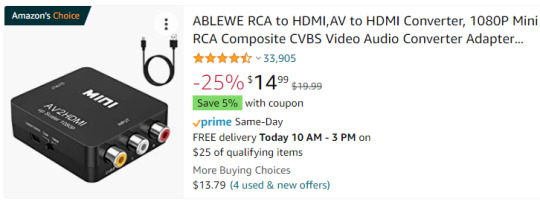
To wrap things up, I want to mention that DKOldies does do online trade ins. Typically when you trade an item into a store, you'll typically get less than the current average value of the item which is how most local game stores deal with trade ins. DKOldies has a page listing their offers for trade ins and they are laughably low.

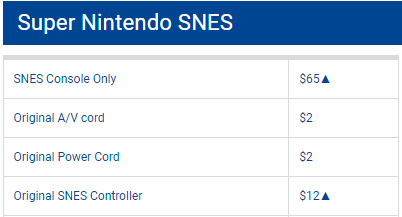
Several folks have even made videos talking about how ridiculous these offers are. DKOldies responded by hiding these prices and requiring that you email them to inquire about the price.
(Source: Retail King)
At the end of the day, DKOldies is a business and their focus is making as much money as possible. They've even made a video directly responding to the backlash they've been getting.
youtube
This video doesn't address any of the points many have made, if anything its propaganda. It's just a small business, a business that overprices the items they sell and is not transparent about their refurbishments. Unless DKOldies gets slapped with a lawsuit (which at this point is inevitable) then my only plea to those getting into used video games is to avoid DKOldies. If you can, buy from local game stores, go thrifting, and if all else fails eBay will absolutely cut you a better deal because everyone else beats DKOldies prices.

79 notes
·
View notes